
Official Edgar Rice Burroughs Tribute and Weekly Webzine Site
Since 1996 ~ Over 10,000 Web Pages in Archive
Presents
Volume 5040

Official Edgar Rice Burroughs Tribute and Weekly Webzine Site
Since 1996 ~ Over 10,000 Web Pages in Archive
Presents
Volume 5040
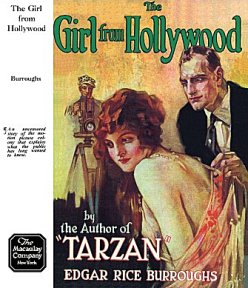
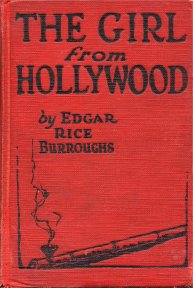
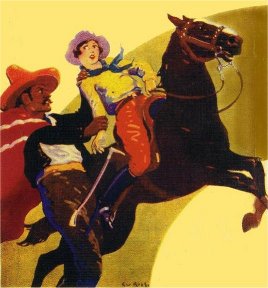
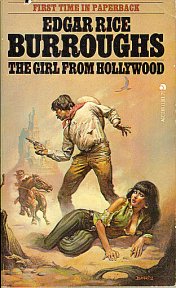
“Her mind is Tiffany twisted, she got the Mercedes bends
She got a lot of pretty, pretty boys she calls friends
How they dance in the courtyard, sweet summer sweat.
Some dance to remember, some dance to forget.”
– The Eagles, “Hotel California”ERB left us all hanging in the last episode about Eva’s fate and, of course, about who killed Wilson Crumb. We are coming to the last stretch of our story. Eva has tried to kill herself because of what she found out about Guy, and Guy went crazy when he heard that Eva had shot herself. I gave my theory that she tried to shoot herself through the heart, but I was only guessing. As it is, everyone expects for her to die like Grace.
CHAPTER THIRTY-FIVE
Eva was still breathing faintly as the sun dropped behind the western hills. Shannon had not left the house all day. She felt that Custer needed her, that they all needed her, however little she could do to mitigate their grief. There was at least a sense of sharing their burden, and her fine sensibilities told her that this service of love was quite as essential as the more practical help that she would have been glad to offer had it been within her power.What do you suppose is the main evidence that warranted their arrest? Let’s see: there was the horseshoe from the Apache that was found under Crumb’s body, and then there was the fact that Shannon had brushed the trail of the Apache at five o’clock in the morning. Did I miss anything, other than the fact that Custer is a convicted criminal?
She was standing in the patio with Custer, at sunset, within the call of Eva’s room, as they all had been during the entire day, when a car drove up along the south drive and stopped at the patio entrance. Three of four men in it alighted and advanced toward them.
“You are Custer Pennington?” one of them asked.
Pennington nodded.
“And you are Miss Burke – Miss Shannon Burke?”
“I am.”
“I am a deputy-sheriff. I have a warrant here for your arrest.”
“Arrest!” exclaimed Custer. “For what?”
He read the warrant to them. It charged them with the murder of Wilson Crumb.“I am sorry, Mr. Pennington,” said the deputy sheriff; “but I have been given these warrants, and there is nothing for me to do but serve them.”It still amazes me at how speedy and personal the criminal justice system in Los Angeles county was in 1921. I was in downtown LA a few years ago with Mario and it was like a cattle call on the stock yard. In the courthouse in which our client was to appear for arraignment – several stories high in the Clara Shortridge Foltz Criminal Justice Center – we waited in line behind twenty other attorneys before the clerk’s bench, and when we finally got up to her, she took the information from us that we would have normally presented before the judge when he took the bench. She said for us not to talk to the judge at all, that he would know what to do from the information she was taking down at the time. But when the judge took the bench and came to our case, I had a question that could not wait. Boy, the look I got from him – well, let’s just say if he had been the Medusa, I would have been turned to stone.
“You have to take us away now? Can’t you wait – until – my sister is dying in there. Couldn’t it be arranged so that I could stay here under arrest as long as she lives?”
The deputy shook his head.
“It would be all right with me,” he said; “but I have no authority to let you stay. I’ll telephone in, though, and see what I can do. Where is the telephone?” Pennington told him.
“You two stay here with my men,” said the deputy sheriff, “while I telephone.”
He was gone about fifteen minutes. When he returned, he shook his head.
“Nothing doing,” he said. “I have to bring you both in right away.”
“May I go to her room and see her again before I leave?”
“Yes,” said the deputy; but when Custer turned toward his sister’s room, the officer accompanied him.
Dr. Baldwin and one of the nurses were in the room. Young Pennington came and stood beside the bed, looking down on the white face and the tumbled curls upon the pillow. He could not perceive the slightest indication of life, yet they told him that Eva still lived. He knelt and kissed her, and then turned away. He tried to say goodbye to her, but his voice broke, and he turned and left the room hurriedly.
Colonel and Mrs. Pennington were in the patio, with Shannon and the officers. The Colonel and his wife had just learned of this new blow, and both were stunned. The Colonel seemed to have aged a generation in that single day. He was a tired, hopeless old man. The heart of his boy and that of Shannon Burke went out to him and to the suffering mother from whom their son to be taken at this moment in their lives when they needed him most. In their compassion for the older Pennington they almost forgot the seriousness of their own situation.
At their arraignment next morning, the preliminary hearing was set for the following Friday.It was the most impersonal system I’d ever seen, but, when you have so many defendants cycling through the system every day, drastic measures have to be taken. I remember saying hello to Mark Geragos, the famous celebrity defense attorney, in the crowded hallway and him acknowledging my greeting. His book, Mistrial, is one of the best books on the criminal justice to date. Thank God for plea bargaining. I don’t look forward to ever practicing in that court again.
Early in the morning Custer had received word from Ganado that Eva still lived, and that Dr. Baldwin now believed they might hold some slight hope for her recovery.The tedious preliminaries of selecting a jury were finally concluded. Wow, talk about speedy justice. I am working on my third death penalty case at the present time, which is June 8, 2014. In my current case in Kings County, three teams of attorneys have already had the case and hardly did a thing since it came before the court in 2006. The other two cases I worked on took years also. Even if someone gets the death penalty, there is always the appellate process. My last client was convicted in 2005 and he has just recently gotten attorneys for his appeal and habeas corpus petitions. They are in the process now of perfecting the record before any briefs are filed in the California Supreme Court, where cases go for automatic appeal when someone has been given the death penalty. And after that, there is the Federal system of appeals. A normal case takes at least twenty years before someone could actually get the death penalty, and even now the method of execution is in doubt. Lethal injection has proven to have as many problems vis-a-vis cruel and unusual punishment, as the gas chamber, and I seriously doubt if anyone will be executed in California for another ten years.
At Ganado, despair and anxiety had told heavily upon the Penningtons. The Colonel felt that he should be in Los Angeles, to assist in the defense of his son; and yet he knew that his place was with his wife, whose need of him was even greater. Nor would his heart permit him to leave the daughter whom he worshipped, so long as even a faint spark of life remained in that beloved frame.
Mrs. Evans returned from Los Angeles the following day. She was almost prostrated by this last of a series of tragedies ordered, as it seemed, by some malignant fate for the wrecking of her happiness. She told them that Guy appeared to be hopelessly insane. He did not know his mother, nor did he give the slightest indication of any recollection of his past life, or of the events that had overthrown his reason.
At ten o’clock on Wednesday night, Dr. Baldwin came into the living room, where the Colonel and his wife were sitting with Mrs. Evans. For two days none of them had been in bed. They were tired and haggard, but no more so than the old doctor, who had remained constantly on duty from the moment when he was summoned. Never had man worked with more indefatigable zeal than he to wrest a young life from the path of the grim reaper. There were deep lines beneath his eyes, and his face was pale and drawn, as he entered the room and stood before them; but for the first time in many hours there was a smile upon his lips.
“I believe,” he said, “that we are going to save her.”
The others were too much affected to speak. So long had hope been denied that now they dared not even think of hope.
“She regained consciousness a few moments ago. She looked up at me and smiled, and then she fell asleep. She is breathing quite naturally now. She must not be disturbed, though. I think it would be well if you all retired. Mrs. Pennington, you certainly must get some sleep – and you, too, Mrs. Evans, or I cannot be responsible for the results. I have left word with the night nurse to call me immediately, if necessary, and if you will all go to your rooms I will lie on the sofa here in the living room. I feel at last that it will be safe for me to leave her in the hands of the nurse, and a little sleep won’t hurt me.” The Colonel took his old friend by the hand.
“Baldwin,” he said, “it is useless to try to thank you. I couldn’t, even if there were words to do it with.”
“You don’t have to, Pennington. I think I love her as much as you do. There isn’t any one who knows her who doesn’t love her, and who wouldn’t have done as much as I. Now, get off to bed all of you, and I think we’ll find something to be very happy about in the morning. If there is any change for the worst, I will let you know immediately.”
In the county jail in Los Angeles, Custer Pennington and Shannon Burke, awaiting trial on charges of a capital crime, were filled with increasing happiness, as the daily reports from Ganado brought word of Eva’s steady improvement, until at last that she was entirely out of danger.But here we are already in jury selection and the actual trial of Custer and Shannon. Note the dark humor in the selection of witnesses and their testimony. Is it any wonder that so many innocent people get convicted in our courts, as DNA evidence is proving over and over, when it is so easy to jump to conclusions, or set someone up for something they didn’t do?
Most people are convinced that if a case is based on circumstantial evidence it will fail, but that is hardly the case in California, where both direct evidence and circumstantial evidence are regarded as the same. The difference is that direct evidence, which establishes a fact, circumstantial evidence must provide a link betwen itself and the direct evidence. A jury instruction informs the jury, as a safeguard, more in word than in practice, that if both the defense and the prosecution offer reasonable explanations about the totality of the circumstantial evidence, that the jury must choose the version most favorable to the jury. The only problem there is convincing the jury when you have a reasonable argument that it is reasonable, because if the prosecution’s argument is reasonable they almost always will go with it regardless of the instruction.
I once visited a jury after they convicted my client of robbing a post office in which identity was a real issue. I gave the jury a list of ten reasonable doubts in the case that demanded a not guilty verdict. In the jury room after, I noticed a blackboard with all ten of my doubts listed. The jurors who remained to discuss the case were very proud that they had found reasonable arguments to overcome each of my ten reasonable doubts. It didn’t matter to them one whit that they were reasonable doubts as long as they could come up with some other reason in favor of the prosecution, forgetting that if both sides came up with reasonable arguments they must chose the one most favorable to the defendant. In that case they did just the opposite. Did I say that the system was not perfect, just the best in the world – most times.
By the way that case impressed on me the horrible ability for almost everyone to guess the amount of time in which something transpires. The robber had gone to all three window tellers and demanded twenties from them, waving a small automatic pistol in their faces. The lowest estimate of time the postal clerks gave was five minutes, the most ten minutes. However, after reviewing the security tapes from the several video cameras that had recorded the incident, the actual time of the robbery from entrance to exit – which was humorous because the robber had tried to exit through the automatic doors the wrong way – was only 45 seconds! Time seems to slow down when you have a gun in your face.
Getting back to the story, it is noteworthy that at the time ERB wrote this novel that several Hollywood scandals were taking place or had just occurred. For example, a famous silent star, Olive Thomas, died in France on September 10, 1920, under mysterious circumstances, and some suspected her husband, the younger brother of Mary Pickford, to be involved. There were many rumors of the couple participating in “champagne and drug orgies.”Then between November 1921 and April 1922, the movie star Roscoe (“Fatty”) Arbuckle went through three highly publicized trials for the rape and manslaughter of the actress Virginia Rapp, after a drug and alcohol orgy in San Francisco. This is the exact time that ERB wrote the story.
Finally, the actor-director Desmond Taylo, was murdered in his Hollywood bungalow on February 1, 1922, also during the period the novel was written. Many people were suspected of shooting him in the back, including the actress Mabel Normand, who was addicted to cocaine, and in 1964, another actress, Margaret Gibson, suspected of prostitution and opium peddling, confessed to killing Taylor. ERB had a lot of history to draw upon for his characters.
ERB knew that the public was mesmerized by Hollywood scandals and likely hoped the interest would drive sales of his book. He made no bones about being an opportunist.
As witness after witness was called, Pennington came to realize for the first time what a web of circumstantial evidence the State had fabricated about him. Even from servants whom he knew to be loyal and friendly the most damaging evidence was elicited. His mother’s second maid testified that she had seen him fully dressed in his room late in the evening before the murder, when she had come in, as was her custom, with a pitcher of iced water, not knowing that the young man was there. She had seen him lying upon the bed, with his gun in its holster hanging from the belt about his waist. She also testified that the following morning, when she had come in to make up his bed, she had discovered that it had not been slept in.As a note of interest, motive is not an element for murder in California. It is always helpful to prove a case if you can establish a motive, but it is not necessary.
The stableman testified that the Apache had been out on the night of the murder. He had rubbed the animal down earlier in the evening, when the defendant had come in from riding. At that time the two had examined the horse’s shoes, the animal having just been reshod. He said that on the morning after the murder there were saddle sweat marks on the Apache’s back, and that the off fore shoe was missing.
One of the K.K.S. employees testified that a young man, whom he partially identified as Custer, had ridden into their camp about nine o’clock on the night of the murder, and had inquired concerning the whereabouts of Crumb. He said that the young man seemed excited, and upon being told that Crumb was away he had ridden off rapidly toward Sycamore Canyon.
Added to all this were the damaging evidence of the detective who had found the Apache’s off fore shoe under Crumb’s body, and the positive identification of the shoe by Allen. The one thing that was lacking – a motive for the crime – was supplied by Allen and the Pennington’s house man.
The latter testified that among his other duties was the care of the hot water heater in the basement of the Pennington home. Upon the evening of Saturday, August 5, he had forgotten to shut off the burner, as was his custom. He had returned about nine o’clock, to do so. When he had left the house by the passageway leading from the basement beneath the south drive and opening on the hillside just above the water gardens, he had seen a man standing by the upper pool, with his arms about a woman, whom he was kissing. It was a bright moonlight night, and the house man had recognized the two as Custer Pennington and Miss Burke. Being embarrassed by having thus accidentally come upon them, he had moved away quietly in the opposite direction, among the shadows of the trees, and had returned to the bunk house.
The connecting link between this evidence and the motive for the crime was elicited from Allen in half an hour of direct examination, which constituted the most harrowing ordeal that Shannon Burke had ever endured; for it laid bare before the world, and before the man she loved, the sordid history of her life with Wilson Crumb. It portrayed her as a drug addict and a wanton; but, more terrible still, it established a motive for the murder of Crumb by Custer Pennington.Owing to the fact that he had lain in a drunken stupor during the night of the crime, that no one had seen him from the time when the maid entered his room to bring his iced water until his father had found him fully clothed upon the bed at five o’clock the following morning, young Pennington was unable to account for his actions, or to state his whereabouts at the time when the murder was committed.I know what you are thinking: why didn’t they send in the CSI team? Forensic science was in its infancy during these days. I’m sure if a bullet had been recovered from Crumb’s body, Custer could have been automatically eliminated by a ballistics test, but that sort of thing is not mentioned by ERB, so it was unlikely that that kind of evidence was used. The test for novel scientific evidence, that it must be accepted by a majority of scientists before it can be admitted – known in California as the Kelly-Frye test – wasn’t in effect in Federal courts until 1923 (Frye), and in California courts until 1976 (Kelly).He realized what the effect of the evidence must be upon the minds of the jurors when he himself was unable to assert positively, even to himself, that he had not left his room that night. Nor was he very anxious to refute the charge against him, since in his heart he believed that Shannon Burke had killed Crumb. He did not even take the stand in his own defense.This is a case where taking the stand could only make matters worse. The prosecutor only need ask him where he was at so and so time on the night of the murder and all he could do would be to say that he couldn’t remember, which is almost an admission of guilt. Best to attack the evidence and credibility of the witnesses alone.The evidence against Shannon was less convincing. A motive had been established in Crumb’s knowledge of her past life and the malign influence that he had had upon it. The testimony of the camp flunky, who had seen her obliterating what evidence the trail might have given in the form of hoofprints constituted practically the only direct evidence that was brought against her. It seemed to Custer that the gravest charge that could justly be brought against her was that of accessory after the fact, provided the jury was convinced of his guilt.Not even I saw that one coming. It’s amazing how these people are willing to lie under oath to take the blame off people they love. Will this lie be different? Or will it only cause more trouble?
Many witnesses testified, giving evidence concerning apparently irrelevant subjects. It was brought out, however, that Crumb died from the effects of a wound inflicted by a forty-five calibre pistol, that Custer Pennington possessed such a weapon, and that at the time of his arrest it had been found in its holster, with its cartridge belt, thrown carelessly upon the bed.
When Shannon Burke took the stand, all eyes were riveted upon her. They were attracted not only by her youth and beauty, but also by the morbid interest which the frequenters of court rooms would naturally feel in the disclosure of the life she had led at Hollywood. Even to the most sophisticated it appeared incredible that his refined girl, whose soft, well-modulated, voice and quiet manner carried a conviction of innate modesty, could be the woman whom Slick Allen’s testimony had revealed in such a role of vice and degradation.
Allen’s eyes were fastened upon her with the same intent and searching expression that had marked his attitude upon the occasion of his last visit to the Vista del Paso bungalow, as if he were trying to recall the identity of some half forgotten face.
Though Shannon gave her evidence in a simple, straightforward manner, it was manifest that she was undergoing an intense nervous strain. The story that she told, coming as it did out a of clear sky, unguessed either by the prosecution or by the defense, proved a veritable bombshell to them both. It came after it had appeared that the last link had been forged in the chain that fixed guilt upon Custer Pennington. She had asked, then, to be permitted to take the stand and tell her story in her own way.
“I did not see Mr. Crumb,” she said, “from the time I left Hollywood on the 30th of July last year, until the afternoon before he was killed; nor had I communicated with him during that time. What Mr. Allen told you about my having been a drug addict was true, but he did not tell you that Crumb made me what I was, or that after I came to Ganado to live I overcame the habit. I did not live with Crumb as his wife. I was afraid of him, and did not want to go back to him. When I left, I did not even let him know where I was going.
“The afternoon before he was killed I met him accidentally in the patio of Colonel Pennington’s home. The Penningtons had no knowledge of my association with Crumb. I knew that they wouldn’t have tolerated me, had they known what I had been. Crumb demanded that I should return to him, and threatened to expose me if I refused. I knew that he was going to be up in the canyon that night. I rode up there and shot him. The next morning I went back and attempted to obliterate the tracks of my horse, for I had learned from Custer Pennington that it is sometimes easy to recognize individual peculiarities in the tracks of a shod horse. That is all, except that Mr. Pennington had no knowledge of what I did and no part in it.”Momentarily her statement seemed to overthrow the State’s case against Pennington; but that the district attorney was not convinced of its truth was indicated by his cross-examination of her and other witnesses, and later by the calling of new witnesses. They could not shake her testimony, but on the other hand she was unable to prove that she had never possessed a forty-five calibre pistol, or to account for what she had done with it after the crime.Some things never change. Geragos has a great chapter in his book about what he calls the angry White Women, like Nancy Grace, who tear into a case before it is resolved always taking the side of the prosecution. Experienced trial attorneys were not surprised by the acquittals of George Zimmerman or Casey Anthony, based on the state of the evidence at the trials, and not on the state of the evidence as put forth by the media. I always feel there is still a chance for American justice when a jury says not guilty, for it means that someone is still following the law.
During the course of her cross-examination many apparently unimportant and irrelevant facts were adduced, among them the name of the Middle Western town in which she had been born. This trivial bit of testimony was the only point that seemed to make any impression on Allen. Any one watching him at the moment would have seen a sudden expression of incredulity and consternation overspread his face, the hard lines of which slowly gave place to what might, in another, have suggested a semblance of grief.
For several minutes he sat staring at Shannon. Then he crossed to the side of her attorney, and whispered a few words in the lawyer’s ear. Receiving an assent to whatever his suggestion might have been, he left the court room.
On the following day the defense introduced a new witness in the person of a Japanese who had been a house servant in the bungalow on the Vista del Paso. His testimony substantiated Shannon Burke’s statement that she and Crumb had not lived together as man and wife.
Then Allen was recalled to the stand. He told of the last evening that he had spent at Crumb’s bungalow, and of the fact that Miss Burke, who was then known to him as Gaza de Lure, had left the house at the same time he did. He testified that Crumb had asked her why she was going home so early; that she had replied that she wanted to write a letter; that he, Allen, had remarked “I thought you lived here,” to which she had replied, “I’m here nearly all day, but I go home nights.” The witness added that this conversation took place in Crumb’s presence, and that the director did not in any way deny the truth of the girl’s assertion.
Why Allen should have suddenly espoused her cause was a mystery to Shannon, only to be accounted for upon the presumption that if he could lessen the value of that part of her testimony which had indicated a possible motive for the crime, he might thereby strengthen the case against Pennington, toward whom he still felt enmity, and whom he had long ago threatened to “get.”
The district attorney, in his final argument, drew a convincing picture of the crime from the moment when Custer Pennington saddled his horse at the stables at Ganado. He followed him up the canyon to the camp in Jackknife, where he had inquired concerning Crumb, and then down to Sycamore again, where, at the mouth of Jackknife, the lights of Crumb’s car would have been visible up the larger canyon.
He demonstrated clearly that a man familiar with the hills, and searching for some one whom sentiments of jealousy and revenge were prompting him to destroy, would naturally investigate this automobile light that was shining where no automobile should be. That the prisoner had ridden out with the intention of killing Crumb was apparent from the fact that he had carried a pistol in a country where, under ordinary circumstances, there was no necessity for carrying a weapon of self-defense. He vividly portrayed the very instant of the commission of the crime – how Pennington leaned from the saddle and shot Crumb through the heart; the sudden leap of the murderer’s horse as he was startled by the report of the pistol, or possibly by the falling body of the murdered man; and how, in so doing, he had forged and torn off the shoe that had been found beneath Crumb’s body.
“And,” he said, “this woman knew that he was going to kill Wilson Crumb. She knew it, and she made no effort to prevent it. On the contrary, as soon as it was light enough, she rode directly to the spot where Crumb’s body lay, and, as been conclusively demonstrated by the unimpeachable testimony of an eye witness, she deliberately sought to expunge all traces of her lover’s guilt.”
He derided Shannon’s confession, which he termed an eleventh hour effort to save a guilty man from the gallows.
“If she killed Wilson Crumb, what did she kill him with?”
He picked up the bullet that had been extracted from Crumb’s body. “Where is the pistol from which this bullet came? Here it is, gentlemen!” He picked up the weapon that had been taken from Custer’s room.
“Compare this bullet with those others that were taken from the clip in the handle of this automatic. They are identical. This pistol did not belong to Shannon Burke. It was never in her possession. No pistol of this character was ever in her possession. Had she had one, she could have told where she obtained it, and whether it had been sold to her or to another; and the records of the seller would show whether or not she spoke the truth. Failing to tell us where she had disposed of it, she can do neither, and the reason which she cannot is because she never owned a forty-five calibre pistol. She never had one in her possession, and therefore she could not have killed Crumb with one.”
When at length the case went to the jury, Custer Pennington’s conviction seemed a foregone conclusion, while the fate of Shannon Burke was yet in the laps of the gods. The testimony that Allen and the Japanese servant had given in substantiation of Shannon’s own statement that her relations with Wilson Crumb had only been those of an accomplice in the disposal of narcotics, removed from consideration the principal motive that she might have had for killing Crumb.
And so there was no great surprise when, several hours later, the jury returned a verdict in accordance with the public opinion of Los Angeles – where, owing to the fact that murder juries are not isolated, such cases are tried largely by the newspapers and the public. They found Custer Pennington, Jr., guilty of murder in the first degree, and Shannon Burke not guilty.We will conclude in the next installment.
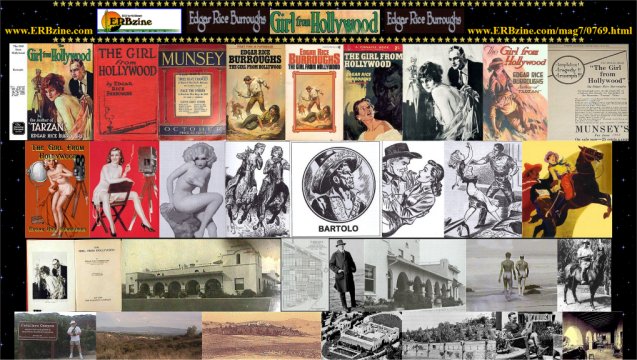
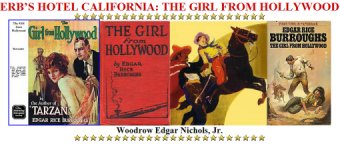
Read
The
Girl From Hollywood Text in ERBzine
See
the ERBzine Bibliography Entry
BACK TO EDGAR RICE
BURROUGHS' TARZANA RANCH 1921 - Docu/Novel
.
![]()
INTRODUCTORY AND CONTENTS PAGE
FOR
THE EDGAR RICE BURROUGHS ARTICLES
BY WOODROW EDGAR NICHOLS, JR.
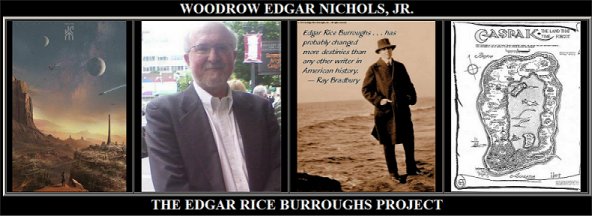
www.ERBzine.com/nichols
|
|
THE TRIMESTERS OF CASPAK |
|
by Woodrow Edgar Nichols, Jr. INTRODUCTION and CONTENTS |
![]()

![]()

BILL
HILLMAN
Visit
our thousands of other sites at:
BILL
AND SUE-ON HILLMAN ECLECTIC STUDIO
All
ERB Images© and Tarzan® are Copyright ERB, Inc.- All Rights Reserved.
All
Original Work © 1996-2014 by Bill Hillman and/or Contributing Authors/Owners
No
part of this web site may be reproduced without permission from the respective
owners.